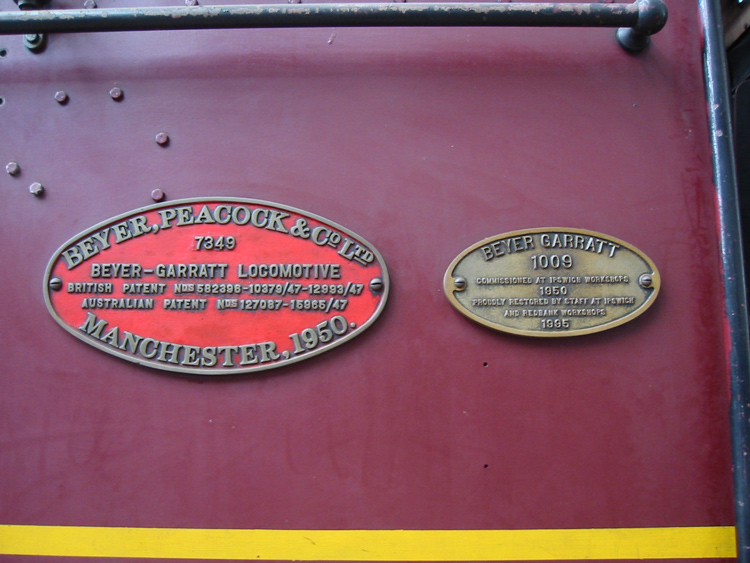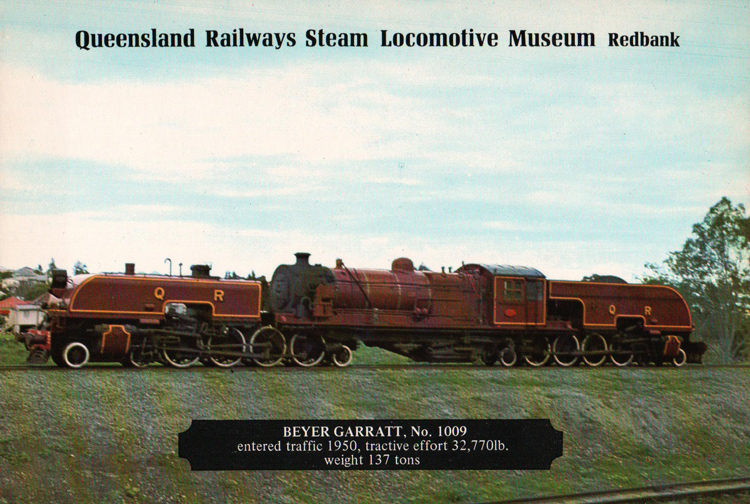|
|
1009 Beyer-Garratt |
|

My thanks to Graham
Watkins for contributing this view:
“Beyer-Garratt 1009 charges out of Mitchelton towards Ferny Grove on one of the Mitchelton Heritage Festival shuttle trips, 23 July 2000.”
|
Builder |
Beyer Peacock
& Co, Manchester |
|
Builder’s Number & Year |
7349 of 1950 |
|
Wheel Arrangement |
4-8-2 + 2-8-4 |
|
No. in class |
30 |
|
Entered Service |
22 September 1950 |
|
Written Off |
17 June 1968 |
|
While
the Queensland Railways administration was unimpressed with the wartime 4-8-2
+ 2-8-4 Australian Standard Garratts (ASGs), it seems they must have warmed
to the advantages of the Beyer-Garratt principle as Beyer Peacock & Co
received an order in the post-war period for 10 locomotives of 4-8-2 + 2-8-4 configuration. These modern Beyer-Garratt locomotives were
delivered in handsome lined maroon livery and proved generally successful, however
their sphere of operation was limited by concerns about narrow single-track tunnel
confines on the “Main Line” through the Main Range to Toowoomba. (Similar concerns were raised for the AD60-class
Beyer-Garratts in NSW; the key issue being that
crews could not escape the cab if the train stalled.) Accordingly, class operations were centred in
the Rockhampton area, where there were no tunnels and the Garratts were found
to steam well on the local Blair Athol coal. A
further 20 engines were ordered from Beyer Peacock & Co, with construction
subcontracted to Societe Franco-Belge
de Material des Chemins-de-Fer, France due to
excess orders at the Beyer Peacock factory in Manchester. (It is interesting to reflect how quickly Beyer
Peacock went from post-war boom to their last steam locomotive builds by 1958
and business closure by 1966.) No.1009
was one the first two class members in service and was placed on display at the
Central Queensland Industries Fair in Rockhampton and Emerald during
1950. 1009 also featured in the
Queensland Railways Centenary celebrations of 1965. While the entire class was written off
between 1968 and 1969, No. 1009 was selected to represent the class in
preservation at the Queensland Railways Steam Locomotive Museum, Redbank. It was prepared for static display and repainted
before posing for official portraits, which were also published as postcards
and available for sale at the Redbank Museum.
1009 was resident at Redbank from 1970 to 1992, where the webmaster remembers
its size clearly dominating the other locomotive exhibits. The
Redbank Steam Locomotive Museum displayed a worthy locomotive collection but
was limited to static display in an artificial "train park"
environment that lacked context, small-exhibits displays and interpretive
functions. Accordingly the need was
recognised for a more comprehensive museum to tell the story of rail transport
in Queensland, resulting in the transformation of a portion of the Ipswich
Workshops into "The Workshops" railway museum. In 1992 the Redbank Museum was closed and most
of the exhibits placed in secure storage, pending the opening of "The
Workshops" in 2002. Rather than
further static display, Beyer-Garratt No.1009 was restored to operation by Queensland
Rail and released to traffic in 1995. No.1009
became somewhat of a celebrity engine during recent tour train duties,
however it developed boiler problems (I understand the fusible plug &/or
foundation ring is leaky) and is currently awaiting repair. No.1009 can now usually be seen stored in
the running shed at The Workshops railway museum, Ipswich. French-built
sister No.1096 was the last of the class in traffic, featuring on occasional
rail enthusiast tour trains.
Unfortunately it suffered a hot axle box and was subsequently scrapped
at Banyo in 1973; the loss of this engine after such a trivial fault seems
tragic in retrospect, but at that time the Queensland Railways had a significant
number of withdrawn steam locomotives in storage and awaiting scrapping. An
excellent book for further reading on this topic is “Crimson Giants - The
Articulated Steam Locomotives of Queensland Rail” by Andrew West, published
by the Australian Railway Historical Society, Queensland Division. This book also details earlier Queensland Railways
experience with Fairlie articulated locomotives, considerations of Shay and
Climax geared designs, and a lengthy section on Queensland Railways’ unloved
and unwanted Australian Standard Garratts. Another excellent resource is this Beyer-Peacock
promotional video showcasing the QR Beyer-Garratts during their heyday,
which also provides an interesting perspective on Queensland in the early
1950’s.
|

Beyer Peacock & Co builder’s plate and Ipswich Workshops “restoration plate” attached to 1009’s cabside. 22 October 2006

An official postcard portrait of 1009 as prepared for
static display at Redbank Museum.
References
|
a |
West
A. M., 'Crimson Giants - The Articulated Steam Locomotives of Queensland
Rail' published by the Australian
Railway Historical Society, Queensland Division, 1995. |
|
b |
"Locomotives
of Australia - 1985 to 2010" (Fifth Edition), by Leon Oberg, published
2010 by Rosenberg Publishing Pty Ltd. |
|
c |
Webmaster’s
observation or comment |
Page updated: 29 April 2015
|
Government Railways: |
|
|||||||||
|
Private & Industrial Railways: |
|